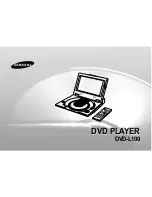
4-16
Fig. C-4-2
Fig. C-4-2
P2 POST ADJUSTMENT
P3 POST ADJUSTMENT
CH-1 CH-2
RF ENVELOPE OUTPUT POINT
HEAD RF SWITCHING OUTPUT POINT
Flatten the waveform by
lightly turning the
guide roller height adjust-
ment screw.
When turning the tracking
control to both sides.
OSCILLOSCOPE
When the tracking control
locates at the center.
Waveform
Connection Diagram
DECK MECHANISM ADJUSTMENT
4. Guide Roller Height Adjustment
4-1. Prior Adjustment
Purpose of adjustment: To ensure that the bottom surface of the tape can travel along with
the tape lead line of the lower drum by constantly adjusting and
maintaining the height of the tape.
4-2. Fine Adjustment
Fig. C-4-1
GUIDE ROLLER
HEIGHT
ADJUSTMENT SCREW
ADJUSTMENT DIAGRAM
Fixtures and tools used
VCR (VCP) status
Adjustment position
Fixtures and tools used
Measuring tools and
VCR (VCP) status
Adjustment position
connection
position
• Post Height Adjusting
• Play or Review Mode
• The guide roller height adjusting screw on the
Driver
supply guide roller and the take-up guide roller
• Oscilloscope
• CH-1: PB RF Envelope • Play the standard test
• Guide roller height
• Standard test tape
• CH-2: NTSC : SW 30Hz tape.
adjusting screw
• Post height adjusting
PAL : SW 25Hz
driver
• Head switching output
point
• RF Envelope output
point
Adjustment Procedure
1) Move the tape and check the bottom surface of the tape
travels along with the guide line of the lower drum.
2) If the tape travels toward the lower part of guide line on
the lower drum, turn the guide roller height adjusting
screw to the left
3) If it travels to the upper part, turn it to the right.
4) Adjust the height of the guide roller to ensure that the
tape is guided on the guide line of the lower drum at the
inlet/outlet of the drum. (Fig. C-4-1)
1) Play the standard test tape after connecting the probe
of oscilloscope to the RF envelope output point and the
head switching output point.
2) Tracking control (playback): Locate it at the center.
(Set the RF output to the maximum value via the track-
ing control when such adjustment is completed after
the drum assembly is replaced.)
3) Height adjusting screw: Flatten the RF waveform.
(Fig.
C-4-2)
4) Move the tracking control (playback) to the right/left.
(Fig.
C-4-3)
5) Check that the start and the end of the RF output
reduction width are constant.
There must exist no crumpling and folding of the tape due
to excess adjustment or insufficient adjustment.
CAUTIONS
Summary of Contents for RCT689H
Page 11: ...1 10 MEMO ...
Page 19: ...2 8 MEMO ...
Page 36: ...3 17 6 7 5 SPDIF_OUT IC1101 6 7 A OUT_R A OUT_L 5 ...
Page 37: ...3 18 MEMO ...
Page 39: ...3 21 3 22 2 SYSTEM BLOCK DIAGRAM ...
Page 43: ...3 29 3 30 6 TUNER BLOCK DIAGRAM ...
Page 53: ...3 49 3 50 8 HDMI CIRCUIT DIAGRAM HDMI MODEL ONLY ...
Page 55: ...3 53 3 54 10 KEY CIRCUIT DIAGRAM ...
Page 59: ...3 61 3 62 PRINTED CIRCUIT BOARD DIAGRAMS 1 VCR P C BOARD TOP VIEW ...
Page 60: ...3 63 3 64 VCR P C BOARD BOTTOM VIEW ...
Page 61: ...3 65 3 66 2 SMPS P C BOARD TOP VIEW BOTTOM VIEW 3 HDMI P C BOARD TOP VIEW BOTTOM VIEW ...
Page 62: ...3 67 3 68 4 KEY P C BOARD TOP VIEW BOTTOM VIEW ...
Page 63: ...3 69 3 70 MEMO MEMO ...
Page 72: ...3 79 2 DV BLOCK TPA TPB 4 3 2 1 1 2 3 4 ...
Page 73: ...3 80 3 USB BLOCK D 1 2 1 2 ...
Page 80: ...3 93 3 94 CIRCUIT DIAGRAMS 1 MPEG CIRCUIT DIAGRAM ...
Page 81: ...3 95 3 96 2 DDR LATCH FLASH RESET CIRCUIT DIAGRAM ...
Page 82: ...3 97 3 98 3 DV1394 INTERFACE CON CIRCUIT DIAGRAM ...
Page 83: ...3 99 3 100 4 RF IC MOTOR DRIVE IC CIRCUIT DIAGRAM ...
Page 84: ...3 101 3 102 5 DSP CIRCUIT DIAGRAM ...
Page 86: ...3 105 3 106 PRINTED CIRCUIT BOARD DIAGRAMS 1 VDR LOADER P C BOARD TOP VIEW BOTTOM VIEW ...
Page 87: ...3 107 3 108 MEMO MEMO ...
Page 119: ...4 32 MEMO ...
Page 136: ...5 17 2 DISC SPECIFICATION 3 DISC MATERIALS 1 DVD ROM ...
Page 141: ...5 22 3 Layout of DVD RW disc ...
Page 142: ...5 23 4 Layout of DVD R RW disc ...
Page 165: ...5 46 MEMO ...
















































